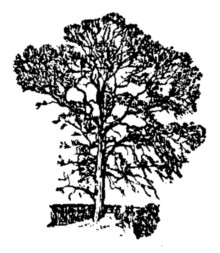Ronald Melville may refer to:
Ronald Melville may refer to:

Herman Melville was an American novelist, short story writer, and poet of the American Renaissance period. Among his best-known works are Moby-Dick (1851); Typee (1846), a romanticized account of his experiences in Polynesia; and Billy Budd, Sailor, a posthumously published novella. Although his reputation was not high at the time of his death, the 1919 centennial of his birth was the starting point of a Melville revival, and Moby-Dick grew to be considered one of the great American novels.

Moby-Dick; or, The Whale is an 1851 novel by American writer Herman Melville. The book is the sailor Ishmael's narrative of the obsessive quest of Ahab, captain of the whaling ship Pequod, for revenge against Moby Dick, the giant white sperm whale that on the ship's previous voyage bit off Ahab's leg at the knee. A contribution to the literature of the American Renaissance, Moby-Dick was published to mixed reviews, was a commercial failure, and was out of print at the time of the author's death in 1891. Its reputation as a "Great American Novel" was established only in the 20th century, after the 1919 centennial of its author's birth. William Faulkner said he wished he had written the book himself, and D. H. Lawrence called it "one of the strangest and most wonderful books in the world" and "the greatest book of the sea ever written". Its opening sentence, "Call me Ishmael", is among world literature's most famous.

Titus Lucretius Carus was a Roman poet and philosopher. His only known work is the philosophical poem De rerum natura, a didactic work about the tenets and philosophy of Epicureanism, and which usually is translated into English as On the Nature of Things and somewhat less often as On the nature of the universe. Lucretius has been credited with originating the concept of the three-age system that was formalised in 1836 by C. J. Thomsen.

Earl of Leven is a title in the Peerage of Scotland. It was created in 1641 for Alexander Leslie. He was succeeded by his grandson Alexander, who was in turn followed by his daughters Margaret and Catherine. Thereafter, there was a dispute relating to succession to the title between David Melville and John Leslie, 1st Duke of Rothes. However, in 1681, Melville's claim was admitted after the Duke of Rothes died. In 1707, Melville succeeded to the title Earl of Melville, and thereafter the earldoms have been united.
Melville Island may refer to:

Jean-Pierre Melville was a French filmmaker and actor. Among his films are Le Silence de la mer (1949), Bob le flambeur (1956), Le Doulos (1962), Le Samouraï (1967), Army of Shadows (1969) and Le Cercle Rouge (1970).
Melville may refer to:
Whyte is a surname and an older English spelling of White, and may refer to:
Melville is a surname and a given name.

The Field Elm cultivar Ulmus minor 'Plotii', commonly known as Lock Elm or Lock's Elm, Plot's Elm or Plot Elm, and first classified as Ulmus sativaMill. var. Lockii and later as Ulmus plotii by Druce in 1907-11, is endemic mainly to the East Midlands of England, notably around the River Witham in Lincolnshire, in the Trent Valley around Newark-on-Trent, and around the village of Laxton, Northamptonshire. Ronald Melville suggested that the tree's distribution may be related to river valley systems, in particular those of the Trent, Witham, Welland, and Nene. Two further populations existed in Gloucestershire. It has been described as Britain's rarest native elm, and recorded by The Wildlife Trust as a nationally scarce species.

The Field Elm cultivar Ulmus minor 'Sowerbyi', commonly known as the Sowerby Elm, was described by Moss in The Cambridge British Flora (1914). The tree, once referred to as the 'Norfolk Elm' by Smith, was commonly found in the hedgerows and woods of Norfolk, Cambridgeshire, and Huntingdonshire in the early 20th century before the advent of Dutch elm disease. Melville considered it a hybrid of 'Coritana'.
The hybrid elm cultivar Ulmus × hollandica 'Elegantissima' was the name given by A. R. Horwood in his Flora of Leicestershire and Rutland (1933) to an elm found in those counties and later identified by Melville as a natural hybrid between Wych Elm and Plot Elm. According to Melville, the hybrid occurs in the main areas of Plot Elm distribution, where it is more common than Plot Elm itself. The tree is sometimes known simply as the 'Midlands Elm'.

Ronald Melville He was an English botanist, based at the Royal Botanic Gardens Kew. He is chiefly remembered for his wartime research into rosehips as a source of vitamin C, prompted by the epidemic of scurvy amongst children owing to the reduced importation of fresh fruit. His research concluded that hips from the common Dog Rose Rosa canina held the highest concentration of the vitamin. In later years, he challenged the two-species taxonomy of the British elms proposed by Richens, identifying five distinct species, several varieties and numerous complex hybrids. Melville assembled a large collection of elm species, varieties and hybrids which are still growing at Royal Botanic Gardens Kew's Wakehurst site.
Archibald Alexander Leslie-Melville, 13th Earl of Leven, 12th Earl of Melville KT DL was a Scottish soldier, and peer.
Alexander Robert Leslie-Melville, 14th Earl of Leven DL was a Scottish peer and soldier.
Robert Melville or Melvill may refer to:

Ulmusaff. 'Plotii', or 'pseudo-Plotii', was the name first used by Melville in the 1940s for elms in England, of various genotypes, that resemble but do not completely match the 'type'-tree, U. minor 'Plotii'. It was taken up again following Dr Max Coleman's findings about Plot Elm (2000) and his paper on British elms (2002).

The Field Elm cultivar Ulmus minor 'Coritana' was originally claimed by Melville, while he was searching in the neighbourhood of Leicestershire in 1936 for U. elegantissima, as a new species, which he called U. coritana. He later recorded its distribution in the counties of Bedfordshire, Berkshire, Buckinghamshire, Cambridgeshire, Essex, Hertfordshire, Leicestershire, Nottinghamshire, Norfolk, Oxfordshire, Suffolk and Warwickshire. Richens, however, dismissed U. coritana as 'an artificial aggregate' of local forms of Field Elm. Bean noted (1988) that Melville's U. coritana was not recognised in the Flora of the British Isles as a species distinct from U. carpinifolia [:U. minor].

Ulmus × diversifolia, also known as the diverse leaved elm, was originally described by Melville in 1939 as a new species, U. diversifolia, though he later believed it a natural hybrid of Coritanian elm, Plot elm and Wych elm. He recorded its distribution in Hertfordshire, between Hatfield, Hertford and Watton-at-Stone, and in Suffolk, where it was common along the coastal plain from Ipswich and Felixstowe to Lowestoft and Beccles, occurring inland as far as Diss and Debenham, and probably extending further north into Norfolk and south towards Colchester, Essex. He accordingly referred to it as "the East Anglian elm".

The elm cultivar Ulmus 'Fastigiata Glabra' was distributed by the Späth nursery, Berlin, in the 1890s and early 1900s as U. montana fastigiata glabra. Späth used U. montana both for cultivars of wych elm and for those of some U. × hollandica hybrids like 'Dampieri'. A specimen of U. montana fastigiata glabra in the Royal Botanic Garden Edinburgh was determined by Melville in 1958 as a hybrid of the U. × hollandica group.